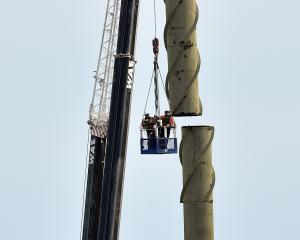Fletcher Building's profit warning last month has been borne out and the Building + Interiors (B+I) project portfolio has posted a $292million loss.
Reported profit for the group plunged 79.7% to $94million.
The B+I loss came from a combination of complex design issues, inadequate project management and stretched resourcing within the under-pressure construction market.
About half of Fletcher's construction division total $2.8billion work was done by B+I, where all but one of about 20 projects was understood to have been done on fixed price contracts, including Auckland's conference centre and the Christchurch justice precinct.
Chief executive of five years Mark Adamson left abruptly last month, replaced overnight by interim chief executive Francisco Irazusta.
Mr Adamson forfeited $8million in bonuses held in Fletcher's long-term share scheme, but got $2.94million on departure in severance and other entitlements.
While overall group sales rose 4% to $9.4billion for its year to June, operating earnings before one-time items declined 23% from $682million a year ago to $525million, while reported profit plunged almost 80%, from $462million to $94million.
Impairments and other one-time charges amounted to $252million, including $69million against its building products division and $153million against its distribution division.
Mr Irazusta said while the result was disappointing, he was confident the B+I business would improve with new leadership and governance now installed, working hard to complete the projects to the highest quality.
''Following a complete review of the B+I portfolio, a significant amount of change has already been implemented, including improved project governance and processes for current and future projects and enhanced bidding rigour,'' he said in a statement.
B+I would be a more focused business, targeting key sectors and clients and would incorporate appropriate risk premiums into margins, he said.
Mr Irazusta said the challenges in B+I performance otherwise masked a robust performance across the remaining portfolio divisions with strong earnings growth. Building Products was up 6%, international up 27%, distribution up 10% and residential and land development up 55%.
If the impact of the B+I loss was discounted, the group's earnings would have increased about 20% and Fletcher's New Zealand portfolio would have expanded earnings by about 30%.
A final dividend of 19c brought the full year to 39c. Fletcher shares were unchanged at $8.20 following the announcement, but down more than 11c on a year ago.
Craigs Investment Partners broker Peter McIntyre said with last month's earnings downgrade pre-released, the focus was on management commentary and outlook.
''Fletcher's did not provide quantitative guidance, unlike last year, instead saying it expects to benefit from a turnaround in construction and modest growth across the remainder of the business,'' Mr McIntyre said.
The poor earnings result was driven by B+I, namely the Christchurch justice precinct and conference centre in Auckland.
''Expected profits on a number of smaller projects have also been revised down,'' he said.
However, Fletcher stated the New Zealand backdrop remained ''generally supportive'' despite cooling house prices, Australian apartments was weakening, but was offset by standalone housing, while infrastructure activity was improving.
Forsyth Barr broker Damian Foster said there was a $30million shortfall in the construction division, principally due to higher B&I construction losses and also the Building Products division, after excluding gains from a property sale, on weaker New Zealand Concrete Pipes & Products.
The standout divisional performers were again distribution, with ebit up 10%, strong performances in Placemakers, NZ Steel Distribution and Stramit, which offset a soft Tradelink result.
Mr Foster said the international performance was driven by the turnaround in Formica Europe from a $17million loss to $4million ebit profit, plus strong 35% ebit growth in Asia.
''At this early stage we expect only modest changes to our forecasts, with the higher depreciation rate and lower Building Products run-rate offset by stronger momentum in Distribution and Formica,'' Mr Foster said.
Mr Irazusta said Auckland needed 13,000 new houses per year. The 10,000 consented last year translated into 8000 actually being built.
''This means there is a shortfall of 5000 houses in the last year alone, so we expect elevated levels of activity to continue, despite some cooling in the Auckland market in the near term.''
Fletcher said the overall impairments included a charge of $222million for its Tradelink and Iplex Australia businesses, representing about 3% of the group's total assets as at June.
The impairment will be reported below the ebit line and have no impact on cash earnings.
''In taking these impairments we are addressing the gap between the balance sheet carrying values of Tradelink and Iplex Australia and their near to medium-term profitability in a tightening Australian economy,'' Mr Irazusta said.
Despite the charges, both businesses were progressing well against their turnaround strategies. Tradelink has opened 20 new stores in 2017, improved its customer proposition and taken market share, while Iplex Australia has returned to profitability for the first time since 2014, he said.













